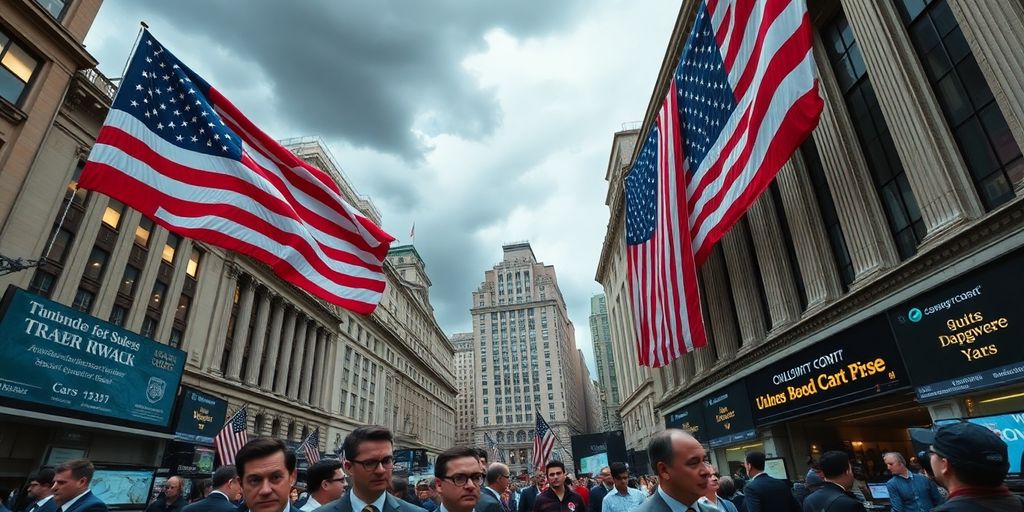In a dramatic turn of events, Wall Street reacted swiftly to the initial news of U.S.-China tariff discussions over the weekend, signaling cautious optimism despite no concrete decisions being announced on tariffs. While the talks may not have yielded immediate agreements, the hints dropped by both nations about potential future actions were enough to send investors into a buying frenzy.
The Initial Impact: Dow, S&P 500, and Nasdaq Surge
Futures for the Dow Jones Industrial Average surged by 401 points, marking a 0.97% increase, while S&P 500 futures jumped 1.15%, and Nasdaq futures soared by 1.45%. Investors were clearly encouraged by the promise of progress, even if details remained scarce. However, the momentum was briefly tempered when President Donald Trump shared on social media plans to sign an executive order aimed at slashing prescription drug prices by up to 80%, which momentarily caused a dip in futures.
Meanwhile, the dollar gained traction, rising 0.1% against the euro and 0.25% versus the yen. Gold, often a safe haven asset during uncertain times, saw a 2% decline to $3,273 per ounce, as the market’s confidence shifted towards the dollar. The 10-year Treasury yield saw a slight uptick, edging up less than 1 basis point to reach 4.382%. U.S. oil prices also saw a modest rise of 0.57%, settling at $61.37 per barrel, with Brent crude climbing 0.49% to $64.22.
U.S. Officials Highlight Progress, No Deal Yet

Treasury Secretary Scott Bessent expressed his satisfaction with the talks, stating, “I’m happy to report that we’ve made substantial progress between the United States and China in the very important trade talks.” He hinted that further details would be revealed during a full briefing scheduled for Monday.
U.S. Trade Representative Jamieson Greer, who was part of the delegation, echoed a similar sentiment. “Just remember why we’re here in the first place—the United States has a massive $1.2 trillion trade deficit, so the president declared a national emergency and imposed tariffs, and we’re confident that the deal we struck with our Chinese partners will help us to work toward resolving that national emergency,” he said.
China’s Response: A “Consultation Mechanism” and De-escalation
On the other side of the table, Chinese Vice Premier He Lifeng confirmed that both nations had agreed to establish a “consultation mechanism” for future discussions on trade and economic issues. While no specific outcomes from the talks were announced, his comments pointed to a willingness to engage in further negotiations and a possible de-escalation of trade tensions.
A Narrow Escape from Worse Outcomes

Although a comprehensive trade agreement wasn’t expected to materialize this weekend, the diplomatic progress between the two global powerhouses offered a glimmer of hope. Following a tumultuous period marked by the imposition of harsh tariffs—145% from the U.S. and 125% from China—these recent talks appeared to soften the rhetoric. Still, as Michael Brown, senior research strategist at Pepperstone, noted, the outcome was far from a concrete deal.
“Not the worst case outcome that was possible from this weekend’s talks, far from it, but not a concrete deal either,” Brown said.
Adding that the weekend’s discussions had, at the very least, laid the groundwork for a more structured dialogue moving forward.
Looking Ahead: The Week’s Economic Reports and Fed Updates
As investors digest the outcome of this weekend’s trade talks, all eyes are now on the key economic reports slated for release in the coming days. The Labor Department will publish its consumer price index (CPI) on Tuesday, followed by the producer price index (PPI) on Thursday, providing fresh insights into inflation as tariffs began to take effect last month.
Additionally, reports on monthly retail sales and industrial production are expected to be released on Thursday, offering further clues into the health of the economy. Federal Reserve officials are also set to make remarks throughout the week, after the central bank kept interest rates steady last week, signaling that it’s not in a rush to adjust rates just yet.
A Tense Trade Landscape Ahead
While the U.S.-China tariff talks may have shown some early signs of progress, much remains to be seen in the coming days and weeks. With economic data about to flood in and more talks between the two nations on the horizon, the situation remains fluid. Traders, investors, and policymakers alike will be watching closely as the global economic landscape continues to evolve.



